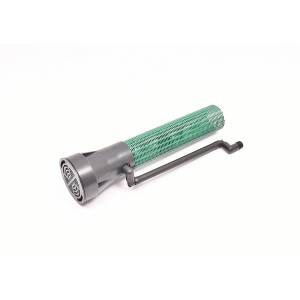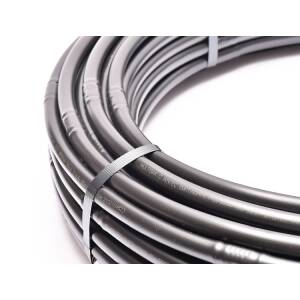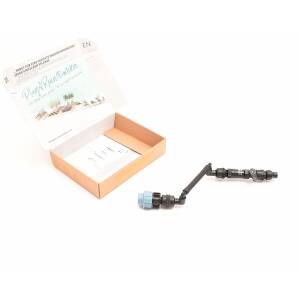Frequently Asked Questions (FAQs)
For large areas, high-performance sprinklers, robust drip pipes and intelligent control systems are particularly suitable. Soil moisture sensors, automatic fertilization systems and subsurface irrigation systems can also be integrated to efficiently distribute water and nutrients. These solutions help to optimize water use and minimize yield losses. This is particularly important in regions with irregular rainfall and high temperatures.
Yes, with the DVS irrigation planner you can create your own irrigation solution. It helps you to determine the water requirements of your plants, the area to be irrigated and the appropriate irrigation technology. Proper planning can reduce costs and increase the profitability of your irrigation system. Everything depends on detailed planning and organization.
The Plug&Rain® system offers pre-assembled components that enable quick and error-free installation. You save time and can set up your irrigation system without complicated individual parts. This reduces the amount of work involved and ensures a long-term water supply for your plants.
Soil moisture sensors measure the moisture in the soil and automatically adjust watering. This prevents both overwatering and drought stress for your plants. Such systems are essential for efficient water distribution and energy use, especially in dry regions with irregular rainfall.
Yes, all systems are modular, so you can add components such as sprinklers, drip pipes or control elements at any time. Choosing the right equipment is crucial for efficiency. Adjustable irrigation is particularly beneficial for farmers who work with cereals, vegetables or other crops.
Regular inspection of filters, drippers and controllers ensures the longevity of your system. Many systems offer automatic flushing features for cleaning. This reduces maintenance and increases the efficiency of your operation.
All components for your large irrigation project can be found in the DVS Beregnung online store. Benefit from a wide range of products, fast delivery and expert advice.
The right planning for efficient irrigation and water demand
Planning is the first step towards an efficient irrigation system. Take into account the size of the area, the water needs of your plants and the rainfall in your region. Different types of soil influence the rootable area and thus the amount of water. Especially in dry areas or with rising temperatures, it is important to use modern irrigation techniques.
Factors influencing the need for irrigation of crops
The need for irrigation of crops is influenced by a variety of factors. These include climate, soil, plant species and current weather conditions. In regions with high temperatures and little precipitation, the water demand of plants is particularly high. Soil conditions also play a crucial role: sandy soils store less water than clay soils and therefore require more frequent irrigation. Each plant species also has specific needs that must be taken into account to ensure optimal irrigation. Well-adjusted irrigation can not only increase yields, but also improve the quality of the plants. It is therefore essential to know the individual requirements of each crop and to adjust the irrigation accordingly.
The best irrigation systems and irrigation technology for large areas
Depending on your requirements, you can choose between different irrigation systems:
- Drip pipes: Ideal for beds, hedges and green roofs. These systems deliver water in the form of drops directly to the roots.
- Sprinkler systems: Perfect for agriculture, arable farming and large open spaces.
- Automatic controllers: Enable efficient and water-saving irrigation.
- Subsurface irrigation: A sustainable method of delivering water directly to the roots.
Efficient irrigation technology
Efficient irrigation technology is the key to sustainable and successful agriculture. There are various techniques that aim to save water while maximizing yields. Drip irrigation, for example, delivers water directly to the roots of plants, minimizing water loss through evaporation. Sprinkler irrigation, on the other hand, distributes water evenly over a larger area and is ideal for arable farming. Modern irrigation systems that are equipped with sensors automatically adjust the irrigation according to the soil moisture and the plants' water needs. Choosing the right technique depends on the specific needs of the plants and the soil. By using efficient irrigation techniques, farmers can not only save water but also improve the health and yield of their crops.
Smart irrigation systems: how do they save water?
Smart irrigation systems offer an advanced solution for using water efficiently and increasing yields. These systems use sensors to monitor soil moisture and other relevant data. Algorithms analyze this data and automatically adjust irrigation to the specific needs of the plants and soil. This ensures that plants receive exactly the amount of water they need, without over- or underwatering. Studies have shown that the use of smart irrigation systems can reduce water demand by over 30%. This is not only ecologically beneficial, but also helps to reduce operating costs and increase the efficiency of agricultural production.
Drip irrigation: an efficient method
Drip irrigation is one of the most efficient ways to save water while improving yields. This technique delivers water directly to the plants' roots, minimizing water loss through evaporation and runoff. This is particularly beneficial in dry regions where water is a scarce resource. Drip irrigation allows for precise control of the amount of water each plant receives, helping to ensure that plants get the optimal amount of water. This method is particularly suitable for growing vegetables, fruits and other crops that require a lot of water. By targeting their irrigation, farmers can improve the health of their plants while conserving water resources.
Installing and operating your irrigation system
Thanks to the Plug&Rain® system, installing your irrigation system is quick and easy. Follow these steps:
- Lay the main lines according to your plan.
- Connect sprinklers or drip pipes with the appropriate connectors.
- Connect the control unit and set the programs.
- Test the system and optimize watering times.
After installation, maintenance consists of regular checks of the filters and drippers. A well-planned and installed irrigation system saves you costs, money and time. Efficient systems not only save water, but also energy.
 Free Online Irrigation-Planner
Free Online Irrigation-Planner






























